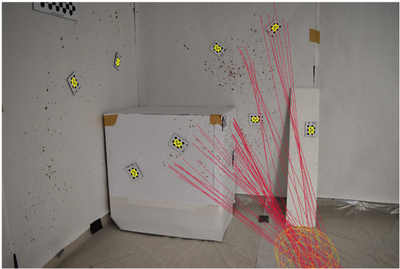Novel Method Developed to Analyze Blood Traces at Crime Scenes
Investigation of crime scenes is essential for police services to find out exactly what happened. This involves manual work that takes a lot of time. KU Leuven developed a new tool ‘HemoVision’ that, using smart algorithms, can analyze blood traces in less than fifteen minutes and display the possible impact on a victim in 3D. Thanks to the expertise of and collaboration with the Federal Judicial Police, the technology could be optimized and tested on real crime scenes. In the event of a crime, traces of blood may end up in the environment. By analyzing this splash pattern, detectives can determine what exactly happened. Unfortunately, these analyzes are very time-consuming and not always easy to perform. When using HemoVision, it is sufficient to upload photos and in less than fifteen minutes the tool provides accurate 3D visualizations of the possible impact on the victim.
“Using smart algorithms, we trained our tool to generate different impact possibilities based on a certain blood trail pattern. Detectives can use these to test their various hypotheses and, if necessary, rule them out. Thanks to the expertise of the forensic department of UZ Leuven and through collaboration with the Federal Judicial Police, we were able to test HemoVision on real crime scenes and adapt it to the needs of future users,” says researcher Philip Joris from KU Leuven and founder of Forentrics, the spin-off behind HemoVision. “The advantage of HemoVision is that the tool not only works quickly but also very accurately. This saves detectives an enormous amount of time and effort,” adds co-founder Ruben Moermans.
“Innovation has always been part of the DNA of the Federal Judicial Police,” explains Laurent Blondiau, acting general director of the Federal Judicial Police (DGJ). “Nevertheless, there has been a need to structure our approach more with the aim of creating an increasingly specialized and effective police force. One of the ways is through structural cooperation between our departments and the academic world.”
“We are happy that we could participate in the development of HemoVision. It will be an asset for the Belgian and international police, but also for society as a whole. The software will save the entire judicial chain a lot of time. Moreover, HemoVision is very visual and makes it easier to understand the facts,” says Sabien Gauquie, director of the Technical and Scientific Police Directorate (DJT).”
The researchers at KU Leuven are not limited to the Belgian police services, but also hope to convince various international players to use HemoVision. “Thanks to €50,000 start-up support from VLAIO, financial support from the KU Leuven Image and Speech Processing research group and the expert advice from KU Leuven Research & Development and the forensic department of UZ Leuven, we can professionally market ourselves as a spin-off. ”, says Philip Joris.

